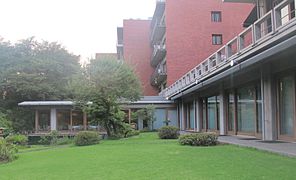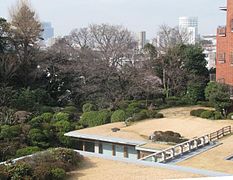Kokusai Bunka Kaikan
The Kokusai Bunka Kaikan ( Japanese 國際 文化 会館 , English International House of Japan , abbreviated "I-House") is a private, non-profit organization opened in 1955 to promote cultural exchange between Japan and abroad. It is located in Roppongi , Tokyo .
prehistory
At the third conference of the American Institute of Pacific Relations in Kyoto in 1929, there was a meeting between John D. Rockefeller III and the internationally active journalist Matsumoto Shigehara (1899–1988). Both emphasized that a cultural component in international relations should complement the political and economic. The Second World War interrupted the further development of this idea.
Rockefeller visited Japan again in 1951, this time as a member of a peace treaty preparation delegation headed by John Foster Dulles . He submitted a recommendation for cooperation in the cultural sector by setting up cultural centers in both countries. The Rockefeller Foundation signaled its support for the implementation, and such a center was planned in Tokyo. Matsumoto was able to get a piece of land from the Japanese government that the Iwasaki family had given the state as a tax payment.
The construction of the house was undertaken jointly by three leading Japanese architects, Maekawa Kunio , Sakakura Junzō and Yoshimura Junzō . The house took a year to complete, but Rockefeller didn't wait and immediately donated $ 100,000 to Columbia University for an intellectual exchange program. Committees were formed for implementation, one at the East Asia Institute at Columbia University and one at Tokyo University, where the political scientist Takagi Yasaka (1889-1984) led the way. The program brought leading American intellectuals to Japan, whose absence Matsumoto had long lamented. The International House finally opened on June 11, 1955.
History of the property
The property of the International House was in the Edo period in the possession of the branch of the Kyōgoku clan , which resided in Tadotsu ( Kagawa Prefecture ). The plot of land on the Torii -zaka slope sloped down to the south, but was heaped up so far by the owners on the southern edge that the green slope created fills the view to the south.
At the beginning of the Meiji period , the then Foreign Minister Inoue Kaoru (1835–1915) acquired the property, to which he often invited guests. In April 1887, for example, Emperor Meiji , his wife and ambassador from various countries were guests. Kabuki is also said to have been performed there and to have sparked new interest in this form of theater.
After Inoue, Prince Kuminomiya, then the entrepreneur Akahoshi Tetsuma (1883–1951) and finally Iwasaki Koyata (1879–1945) owned the property. After the Second World War, the property fell to the state.
The plant today
The I-House has an event hall, party rooms, two restaurants, a library with 28,000 books and 420 periodicals, and guest rooms. In 1976 a new wing was added, and in 2006 the old wing was renovated. The house is freely accessible, but only members or people introduced by members can stay overnight. In 2013 there were 13,000 overnight stays by scientists from 50 countries. The I-House is also active as a publisher.
There is basic funding for the company through donors and membership fees. In addition, there is the income from ongoing operations. Of the approximately 3,000 personal members, two thirds are Japanese. Americans make up two-thirds of the third foreigners, there are 31 German members. There are also companies and institutions as members, a total of around 300. These are mainly Japanese institutions, on the German side the Japanese-German Center Berlin is involved.
photos
Remarks
- ↑ Son of the founder of the Mitsubishi concern Iwasaki Yatarō .
literature
- International House of Japan (Ed.): Annual Report 59 , 2014.
- S. Noma (Ed.): International House of Japan . In: Japan. An Illustrated Encyclopedia. Kodansha, 1993, ISBN 4-06-205938-X , p. 615.
Web links
- International House of Japan website (Japanese, English)
Coordinates: 35 ° 39 ′ 29.6 ″ N , 139 ° 44 ′ 0.6 ″ E






